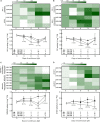Regulation of Ascorbate Accumulation and Metabolism in Lettuce by the Red:Blue Ratio of Continuous Light Using LEDs
- PMID: 32547589
- PMCID: PMC7272677
- DOI: 10.3389/fpls.2020.00704
Regulation of Ascorbate Accumulation and Metabolism in Lettuce by the Red:Blue Ratio of Continuous Light Using LEDs
Abstract
Ascorbate (AsA), an antioxidant that cannot be synthesized and stored by the human body, plays an essential role in the proper functioning of both plants and humans. With the goal of increasing the AsA level in lettuce, the effects of different ratios of red (R) to blue (B) light (75R:25B, 50R:50B, and 25R:75B) on AsA pool sizes as well as the transcript levels and activities of key enzymes involved in AsA metabolism were constantly monitored for 12 days under continuous light (200 μmol⋅m-2⋅s-1) from LEDs. The results showed that lettuce biomass was positively correlated with the ratio of red light, while the AsA pool size had a positive correlation with the ratio of blue light during the whole experiment. The 25R:75B treatment increased the expression of genes involved in AsA biosynthesis (GMP, GME, GGP, GPP, GLDH) and regeneration (APX, MDHAR, DHAR, and GR) on day 3 but only significantly elevated the activities of enzymes involved in AsA regeneration (APX, MDHAR, DHAR, and GR) subsequently. AsA regeneration enzymes (MDHAR, DHAR and GR) had greater correlations with the AsA level than the AsA synthesis enzyme (GLDH). Thus, it is concluded that a high ratio of blue light elevated the AsA level mainly by promoting AsA regeneration rather than biosynthesis. Taken together, altering the red:blue ratio of continuous light from high to low before harvest is recommended for lettuce cultivation to achieve both high yield and high quality.
Keywords: ascorbic acid; enzyme activity; expression level; light quality; regulatory mechanism.
Copyright © 2020 Zha, Liu, Yang, Zhang, Zhou and Shao.
Figures






Similar articles
-
LED Light Quality of Continuous Light before Harvest Affects Growth and AsA Metabolism of Hydroponic Lettuce Grown under Increasing Doses of Nitrogen.Plants (Basel). 2021 Jan 19;10(1):176. doi: 10.3390/plants10010176. Plants (Basel). 2021. PMID: 33477815 Free PMC article.
-
Dynamic Responses of Ascorbate Pool and Metabolism in Lettuce to Light Intensity at Night Time under Continuous Light Provided by Red and Blue LEDs.Plants (Basel). 2021 Jan 23;10(2):214. doi: 10.3390/plants10020214. Plants (Basel). 2021. PMID: 33498607 Free PMC article.
-
High temperature inhibits ascorbate recycling and light stimulation of the ascorbate pool in tomato despite increased expression of biosynthesis genes.PLoS One. 2013 Dec 19;8(12):e84474. doi: 10.1371/journal.pone.0084474. eCollection 2013. PLoS One. 2013. PMID: 24367665 Free PMC article.
-
Genetic and biochemical strategies for regulation of L-ascorbic acid biosynthesis in plants through the L-galactose pathway.Front Plant Sci. 2023 Mar 15;14:1099829. doi: 10.3389/fpls.2023.1099829. eCollection 2023. Front Plant Sci. 2023. PMID: 37021310 Free PMC article. Review.
-
Metal/metalloid stress tolerance in plants: role of ascorbate, its redox couple, and associated enzymes.Protoplasma. 2014 Nov;251(6):1265-83. doi: 10.1007/s00709-014-0636-x. Epub 2014 Mar 29. Protoplasma. 2014. PMID: 24682425 Review.
Cited by
-
Application of Light-Emitting Diodes for Improving the Nutritional Quality and Bioactive Compound Levels of Some Crops and Medicinal Plants.Molecules. 2021 Mar 9;26(5):1477. doi: 10.3390/molecules26051477. Molecules. 2021. PMID: 33803168 Free PMC article. Review.
-
Light Intensity- and Spectrum-Dependent Redox Regulation of Plant Metabolism.Antioxidants (Basel). 2022 Jun 30;11(7):1311. doi: 10.3390/antiox11071311. Antioxidants (Basel). 2022. PMID: 35883801 Free PMC article. Review.
-
Challenges and Opportunities of Light-Emitting Diode (LED) as Key to Modulate Antioxidant Compounds in Plants. A Review.Antioxidants (Basel). 2020 Dec 31;10(1):42. doi: 10.3390/antiox10010042. Antioxidants (Basel). 2020. PMID: 33396461 Free PMC article. Review.
-
LED Light Quality of Continuous Light before Harvest Affects Growth and AsA Metabolism of Hydroponic Lettuce Grown under Increasing Doses of Nitrogen.Plants (Basel). 2021 Jan 19;10(1):176. doi: 10.3390/plants10010176. Plants (Basel). 2021. PMID: 33477815 Free PMC article.
-
Ozone uptake at night is more damaging to plants than equivalent day-time flux.Planta. 2021 Feb 24;253(3):75. doi: 10.1007/s00425-021-03580-w. Planta. 2021. PMID: 33629150 Free PMC article.
References
-
- Alhagdow M., Mounet F., Gilbert L., Nunes-Nesi A., Garcia V., Just D., et al. (2007). Silencing of the mitochondrial ascorbate synthesizing enzyme L-galactono-1,4-lactone dehydrogenase affects plant and fruit development in tomato. Plant Physiol. 145 1408–1422. 10.1104/pp.107.106500 - DOI - PMC - PubMed
-
- Aro E. M., Valanne N. (1979). Effect of continous Light on CO2 fixation and chloroplast structure of the mosses Pleurozium schreberi and Ceratodon purpureus. Physiol. Plant 45 460–466. 10.1111/j.1399-3054.1979.tb02614.x - DOI
-
- Bartoli C. G., Guiamet J. J., Kiddle G., Pastori G. M., Di Cagno R., Theodoulou F. L., et al. (2005). Ascorbate content of wheat leaves is not determined by maximal l-galactono-1,4-lactone dehydrogenase (GalLDH) activity under drought stress. Plant Cell Environ. 28 1073–1081. 10.1111/j.1365-3040.2005.01338.x - DOI
LinkOut - more resources
Full Text Sources
Miscellaneous

